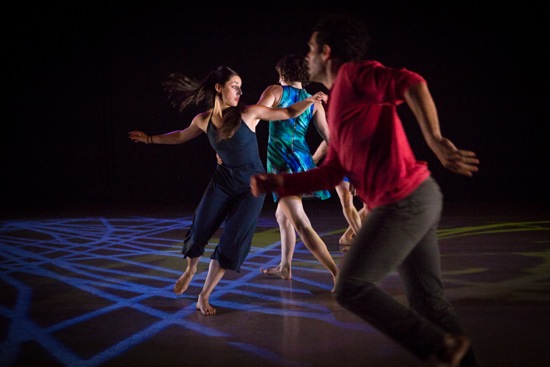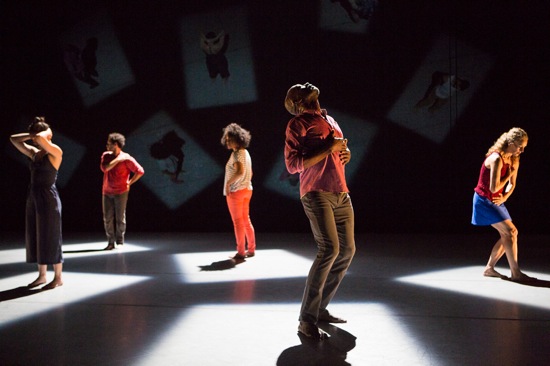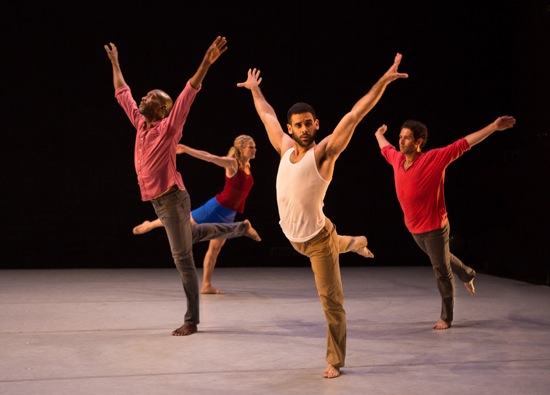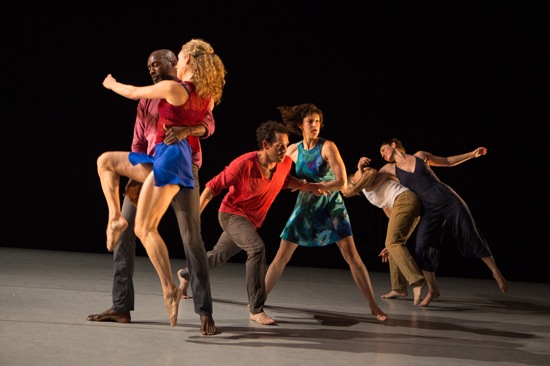Jane Comfort and Company premieres You Are Here at The Kitchen

(L to R): Cori Marquis, Gabrielle Revlock, and Darrin Wright in Jane Comfort’s You Are Here. Photo: Yi-Chun Wu
Jane Comfort has a formidable history as one who attacks with an intellectual cleaver subjects that most choreographers avoid: government policies, sanctioned torture, public apathy, gender stereotypes, beauty contests, talent shows. She deconstructed Shakespeare (Cliff Notes Macbeth, 1980) and Tennessee Williams (Faith Healing, 1993). However, her last-year’s Altiplano showed her more mellow side—telling no stories and focusing on images drawn from the life and atmosphere of the high desert.
Comfort’s new You Are Here (premiering on the American Dance Institute’s series at The Kitchen) revisits themes of city life: solitude amid populated streets, traffic patterns, and unexpected collisions. (These are so familiar to us that you want to call her daring for even tackling them). In the urban climate she conjures up, the few vignettes that suggest violence are shown isolated from cause and effect —vivid, but somehow cleansed, like newspaper photos. She seems to be affirming that it takes grace, endurance, and tolerance to live in a place like Manhattan.
She gives us plenty of time to acclimate and to identify the performers. One by one, they enter the performing space and start walking in individual right-angled paths. Darrin Wright sets the pace by walking the perimeter. Then come Cori Marquis, Leslie Cuyjet, Javier Perez, Petra van Noort, Gabrielle Revlock, Paul Hamilton. Some are dressed casually, others are more elegant (costumes by Liz Prince). They look straight ahead and keep to their paths. Walk, walk, walk.
At some point, they start to change directions more frequently. Then van Noort barely grazes Hamilton. Another near collision occurs. Marquis and Perez actually bump and have to take a step backward to recover. The paths, the contacts, and the pace alter, but these people remain polite (a city dweller’s defensive tactic). As they reform into two lines facing each other, the atmosphere is heightened by Joe Levasseur’s splendid lighting, and Lianne Arnold’s ditto video designs. Brandon Wolcott’s sensitive music and sound design begins with hollow sonorities and metallic percussion.

Alone together (L to R): Cori Marquis, Darrin Wright, Leslie Cuyjet, Paul Hamilton, and Petra van Noort. Photo: Yi-Chun Wu
You might at first think that the dancers are playing some kind of game. One person crosses the gap between lines and joins the opposite one. Others do the same. But flashes of light, vague shapes on the back wall, and increasing haste evoke the daily hazard of crossing a midtown street controlled by changing traffic lights. Comfort, then, is abstracting experiences. After a few moments of the performers tangling with, assisting, or lifting one another, drum rolls and rectangles of light on the floor isolate them in lonely habitats (I think back to Anna Sokolow’s iconic 1955 Rooms). Silence. They make small, individual adjustments, e.g. Marquis twists her long hair into a bun, Hamilton uses one hand like a mirror. Live-feed images of them pepper the back wall.
They do dance—group behavior with an even rhythm and an interplay between unison and counterpoint. A repetitive piano melody is overwhelmed by traffic noise. Gender doesn’t seem to be an issue. Occasional dramas are hinted at. After a startlingly loud buzzing, a glare of light, and a lot of running, Perez gets to be a person in charge—maybe a club doorman. The others line up and approach him one at a time. Charming, accommodating or dismissive, he responds. They may circle him, embrace him, nuzzle him, argue with him silently. He fixes the foot of one of them (Revlock, who’s crazily naïve and gawky about free-form dancing). After finishing these encounters, they all end up in a heap at one side of the stage.

L to R: Paul Hamilton, Petra van Noort, Javier Perez, and Darrin Wright. Photo: Yu-Chu Wu
Comfort’s city mostly hides the dark side that many of us rarely see but that others see almost daily. Later in You Are Here, Perez ends up pushed against the back wall, facing it, spread-eagled, his hands raised. Then he exits, and a video takes over. I can’t make it out the horizontal waves at first, but they turn out to be a gray-black-white vision of passing subway trains, almost life-sized. The familiar rendered unfamiliar in a social atmosphere in which those two qualities joust every day. The distinctive people onstage form alliances that must be temporary. Marquis and Revlock fall into unison. Cuyget and van Noort lounge on the floor to watch Hamilton and Perez. They pair up. As a projected image of city buildings rises into distortion, Wright dances alone—a marvel of sinuous twists and turns around himself as if he were seeking equilibrium in a cockeyed world.
When his colleagues return in new, bright attire and lights and patterns flash and a low beat feeds in, You Are There begins to feel overextended. We’re more than ready for Hamilton and Wright to hold each other close, as if they’re the last ones left on the dance floor before the music stops and it’s closing time.

Jane Comfort’s You Are Here. (L to R): Paul Hamilton and Petra van Noort, Darrin Wright, Gabrielle Revlock, Javier Perez, and Cori Marquis. Photo: Yi-Chun Wu
However, Comfort has planned a surprise not hinted at in the program. While the wonderful, idiosyncratic performers (and contributors to the choreography) enter again and walk as they did at the beginning of the evening, newcomers appear among them. Dancers and others associated with dance. People we know and people we’ve never seen before. People of different ages. Comfort is among them; so are her actor son and her silver-haired husband. A woman holds a tiny child by the hand. This isn’t wildly diverse New York, but it’s the world we’re in tonight. Some of us are the lucky ones—those who read about, work with, and sympathize with others not so lucky. Just look around the theater. We are here too.

Deborah, thanks for putting me in my first, and most likely last, dance review in New York. You are clearly a very discerning critic.
Nice, makes me homesick for New York, it does.
Too bad more dance writers don’t write like this.
Insight and fine prose. Ain’t many can do that.